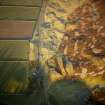Stanhope Cottage
Enclosure (Prehistoric)
Site Name Stanhope Cottage
Classification Enclosure (Prehistoric)
Alternative Name(s) Easter Stanhope
Canmore ID 49907
Site Number NT13SW 17
NGR NT 1242 3007
NGR Description NT 1238 3000 and NT 1242 3007
Datum OSGB36 - NGR
Permalink http://canmore.org.uk/site/49907
- Council Scottish Borders, The
- Parish Drumelzier
- Former Region Borders
- Former District Tweeddale
- Former County Peebles-shire
NT13SW 17 1238 3000 and 1242 3007
(NT 1240 3012) Enclosure (NR)
OS 6" map, (1967).
An enclosure, measuring 120' (36.6m) by 90' (27.4m) within a wall which now appears as a stony bank 12' (3.7m) wide, is situated 45 yds (41m) NNE of the scooped settlement NT12NW 47. The entrance, 5' (1.52m) in width, is on the W. The only feature in the interior is an isolated low bank of unknown purpose. The wall of the enclosure is broken on the SSE and NW by a small stream which now passes through the interior. Although nothing is known about the date of the enclosure, it is possible that it was contemporary with the scooped settlement.
RCAHMS 1967, visited 1956.
The entrance to the enclosure is not clear due to several mutilations. Re-surveyed at 1:2500.
Visited by OS (RDL) 16 March 1964 and (IA) 5 September 1972
Field Visit (July 1989 - August 1989)
NT12NW 55 12 29.
An important group of settlements and cultivation remains is concentrated at the mouth of the Stan Hope, around the modern farms of Easter and Wester Stanhope. To the SW of the Stanhope Burn, the earliest of these settlements are probably the ring-ditch houses NT12NW 36-7 on the NW flank of Laigh Hill. The fort NT12NW 5 overlooking Wester Stanhope was probably the next structure to be built followed by the homestead that overlies its outer rampart, the homestead NT12NW 34 below it and the scooped settlement NT12NW 32 adjacent to the ring-ditch houses on the SW flank of Laigh Hill. Perhaps overlapping in date with these undefended homesteads and settlements is the dun NT12NW 6.
The next classifiable structures are the farmsteads NT12NW 4, one of which contains a substantial building, possibly the building referred to as a tower in 1645 (see NT12NW 3). This building clearly overlies its surrounding enclosure whose date, along with the enclosure NT12NW 33 below the fort, is unknown. Around these settlements are numerous fragments of banks none of which form a coherent pattern. Some of them, particularly those around the rig-and-furrow cultivation at Wester Stanhope are probably of relatively recent date, but others may be considerably earlier. On the NW flank of Laigh Hill for instance there are traces of some very slight banks (eg NT 1154 2939 to 1160 2934 and centred 1178 2953), and a small cluster of cairns (NT 1167 2946), most of them entirely robbed, but there is very little trace of any rig-and-furrow. Indeed, there is some evidence on this hill-side of artificially smoothed areas, a type of feature that cannot be expected to survive any subsequent ploughing.
To the N of the Stanhope Burn a slightly different pattern emerges.
Here there is what is presumably an Early Bronze Age burial cairn NT13SW 53, and two undefended settlements NT12NW 2 and 55 comparable to those SW of the Stanhope Burn. Adjacent to one of the settlements is a large enclosure NT13SW 17. Between the two settlements and the Stanhope Burn there are two small fermtouns NT12NW 46 and 48, whose buildings are of different character to those of the farmsteads on the SW side of the burn (NT12NW 4) and may be of different date. Extending northwards from Easter Stanhope there is another complex of field-banks and rig-and-furrow. The rig-and-furrow, most of which is curving and quite well formed probably reflects several separate phases of cultivation and can be shown to post-date most of the banks that drop down on the uphill side of the track. There is no evidence, however, that these banks are related to either of the settlements or the enclosure. At one point some of the rig-and-furrow is overlain by an old sheepfold NT13SW 52. The rig-and-furrow that now survives at Stanhope is clearly no more than a fragment of the areas under cultivation in the pre-improvement period; Roy's Map (1747-55) shows that the whole of the haughland, which is now enclosed by substantial drystone walls, was under plough.
Visited by RCAHMS (SPH) July/August 1989.
Field Visit (July 1989)
NT13SW 17 1238 3000 and 1242 3007
The enclosure and settlement shown on this map sheet are wrongly positioned. The settlement is on NT12NW 47, and the enclosure straddles the burn adjacent to the modern fence at NT 1242 3007. The enclosure is otherwise as described but a trench to take the cable for a television aerial has been cut across it.
Visited by RCAHMS (SPH) July 1989.
Sbc Note
Visibility: This is an upstanding earthwork or monument.
Information from Scottish Borders Council






















































